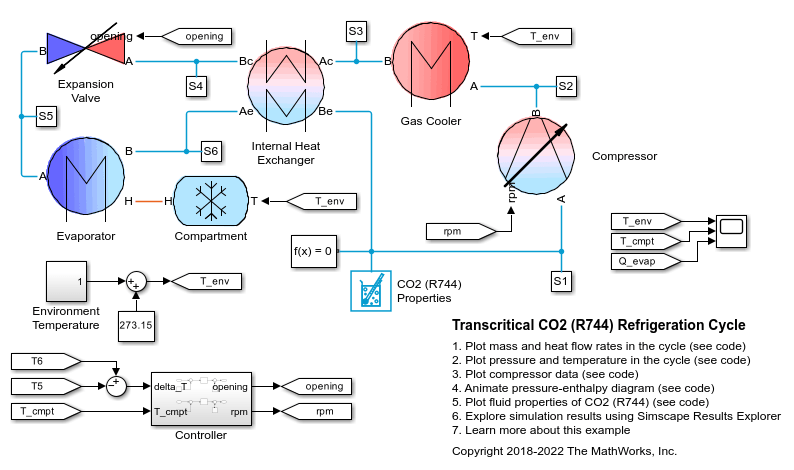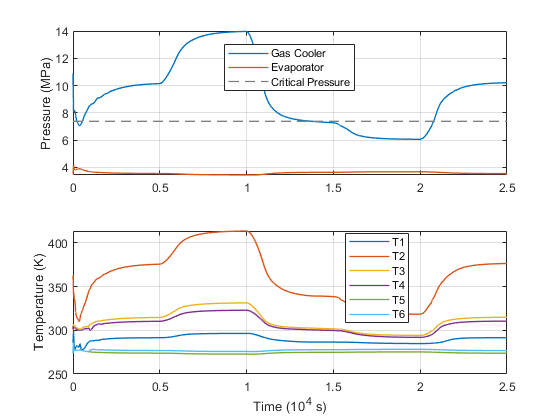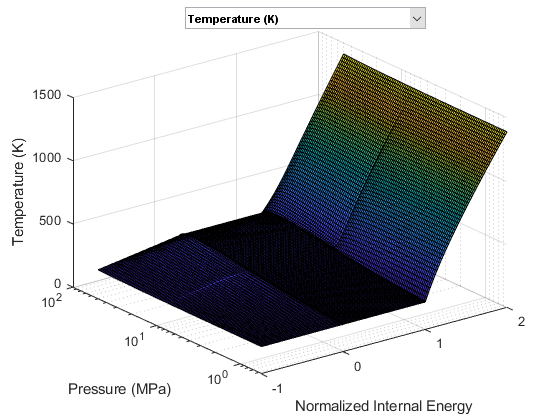跨临界 CO2 (R744) 制冷循环
此示例对蒸汽压缩制冷循环进行建模,其中循环的高压部分在超临界流体区域中运行。制冷剂是二氧化碳 (CO2),在此应用中也称为 R744。
压缩机驱动 CO2 在整个循环中流动,并将压力升高到临界压力以上。气体冷却器将高压 CO2 产生的热量排出到环境中。由于 CO2 处于超临界状态,因此它不会凝结,温度也会下降。膨胀阀会降低压力,使一些 CO2 气化。两相混合物通过蒸发器,从间室吸收热量,直至过热。内部热交换器在循环的热侧和冷侧之间传递一些热量,以提高循环的效率。
模型

隔间子系统

压缩机子系统

控制器子系统

蒸发器子系统

膨胀阀子系统

气体冷却器子系统

内部热交换器子系统

来自示波器的仿真结果

来自 Simscape 记录的仿真结果
以下绘图显示了循环中的质量流量、等熵压缩机功率输入和热流量。气体冷却器和蒸发器的热流量表示循环的散热和吸热,而 IHX 热流量是指内部热交换器在循环内的热传递。

以下绘图显示了循环中不同点的压力和温度。蒸发器压力保持在 3.5 MPa 左右,气体冷却器压力一般约为 10 MPa,高于 CO2 (R744) 的临界压力 7.4 MPa。因此,这是一个跨临界制冷循环。气体冷却器压力随环境温度的变化而变化。在较低的环境温度下,气体冷却器压力可能会降至亚临界压力。
由于进入蒸发器的是两相混合物,因此蒸发器入口温度 T5 也是饱和温度。因此,T6-T5 表示蒸发器中过热,由膨胀阀控制。

以下绘图显示了不同轴速度下的压缩机压力与流量曲线。这里没有对旋转轴进行建模;控制器直接设置轴速度来产生必要的流量。

Simscape 记录结果的动画形式
下图展示了跨临界制冷循环中流体状态随时间的演变。循环中的 6 个点分别是压缩机入口、冷凝器入口、内部热交换器热侧入口、膨胀阀入口、蒸发器入口和内部热交换器冷侧入口,由模型中的传感器 S1 至 S6 进行测量。测量值果绘制在压力-焓图上。轮廓是 CO2 (R744) 的等温线。

流体属性
下面两幅图绘制了 CO2 (R744) 的流体属性分别随压力 (p) 和归一化内能 (unorm) 以及随压力 (p) 和比内能 (u) 的变化。情况如下:
当 -1 <= unorm < 0 时,液体为过冷液体;
当 0 <= unorm <= 1 时,流体为两相混合流体;
当 1 <= unorm <= 2 时,流体为过热蒸气;
流体属性数据以 p 和 unorm 表示的矩形网格提供。因此,以 p 和 u 表示的网格是非矩形的。
可以在 CO2PropertyTables.mat 中找到 CO2 (R744) 流体属性。

